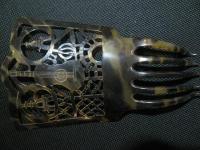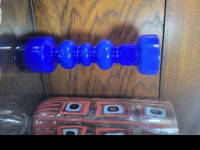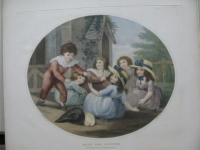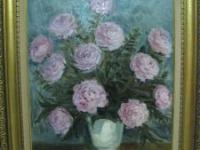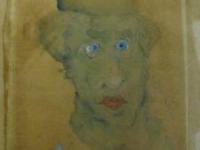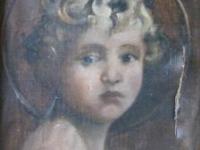Revisions and price adjustment executed on March 19, 2025.
Offered here, and on ebay, is a 4 volume set of the 1978 Jackson Pollock Catalogue Raisonne', plus the 1995 Supplement Number One, making it the complete set of 5 volumes of artworks and other information regarding Jackson Pollock. In addition, the set is accompanied by an original painting which is similar in style, technique, and execution to a number of paintings and drawings by Jackson Pollock. I am also including a copy of the McMullen Museum of Art catalog, "Pollock Matters."
See it at : https://www.ebay.com/itm/256620138778
Viewers, before passing judgment or attempting to make any claims, please examine the images carefully and read all the information in the essay I've provided. I welcome questions, comments, and critiques. Any allegations that this artwork has a history of theft must be provided with lawfully executed evidentiary documentation to support such claims.I guarantee that this painting is not a reproduction, copy or "fake," and I believe that it dates to about the mid to late 1940s
ABOUT THE PAINTING:The artwork in this listing is an enamel and oil paint on the smooth side of a Masonite board that is fixed to a piece of recycled plywood, of which appears to have been part of a window shutter. The face of the shutter around the painting is painted black,but was done so over the same color paint that appears in the background of the painting. The reverse side of the shutter board retains the original finish, and it also reveals a couple of fingerprints and groups of numbers or matrices, and other doodling in pencil.
The background of the unsigned painting covers the entire Masonite board that measures 32-1/2 x 12 inches, and it has a manufacturer stamp that reads "MASONITE K" on the back. I believe the Masonite board dates to around the mid 1930s to early 1940s. The shutter board measures 36-1/2 x 17 inches.A fastidious detail worth mentioning is that rather than the Masonite being fixed directly to the shutter board it was precisely placed on very thin wood strips about 1/4 inch thick and 1 inch wide. Assuming a reason, I would suggest that the purpose was to create dimensionality, or to enhance the illusion of the work being three dimensional.
Why we believe this painting is by Jackson Pollock?Our painting not only displays a very specific technique that is completely original to Jackson Pollock, but it also incorporates symbolic images that appear repeatedly in many of Jackson Pollock's various works from about the late 1930s. The most obvious are figurations that appear to represent a snake. horse's head, symbolic semi circles and spirals, figures with outstretched limbs, dots that follow a specific pattern, and a very peculiar symbol that is similar to what Pollock referred to as "divining rods." An early example of Pollock's, in which some figurations of similarity appear, is a small painting titled "Circle" executed circa 1938-1941. Additionally, there is not a single element of line, color, form, shape, texture, value, space or movement in this painting that could possibly be construed as random effects, but are in fact "intentional."
FINGERPRINTS:I have to mention the fingerprints for two reasons. First; In recognition of the fact that Jackson Pollock threw paints onto his canvases and he handled those works at some point, it seems that there is an intentional lack of study as to whether a full set of his prints can be gathered from all the canvases and other mediums he handled. I wouldn't accept for a second from anyone that Pollock didn't get any paint on his hands while handling his works, or that he cleaned his hands before doing so. Secondly; Because Jackson Pollock's works are some of the most important in the world, I would think that obtaining a verified set of Jackson Pollock's fingerprints from all known works that can be had, should be an absolute priority for the purpose of identifying lost works so that Pollock's oeuvre will be more complete.
APPLICATIONS:Beginning with the background color, the paint was applied in the thinnest possible manner leaving surface areas of the board to bleed through. There is no evidence of brushwork or tools, so I am perplexed as to the method of application. The next layer of gray and/or silver is an example of poured paint(s) with little viscosity, and which appears to be a mixture of paints and a solvent or thinning agent that caused separation of the colors, but allowed the mix to flow in the desired direction by hand manipulating the angle of the Masonite.
The consistency of paints applied thereafter becomes slightly thicker with each layer. The black and white paints appear to have been applied by use of an instrument that allowed the artist to actually draw the figurations in both bold and super fine lines, thus giving the painting a three dimensional appearance, of which is no easy feat for even the most experienced artist. In fact, this painting is an extraordinary and brilliant example of "fluid mechanics" that displays the mind and hand of an artist who knew exactly how to use the medium and deliver the subject to the viewer with extreme precision and clarity, as intended.A paper by researchers at Brown's School of Engineering provides an observation by co-author Professor Roberto Zenit. Dr. Zenit mentions that the term "drip painting: is a misnomer in that Pollock avoided dripping, but instead favored unbroken filaments of paint that stretched across the canvas." His statement is consistent with the technique of fluid mechanics present in our painting.
Examination of each figure reveals that they are not random, but a deliberate repetition of similar patterns. The evidence displayed by the figures in this painting are consistent with observations by art scholars and research analysts who refer to such as "Fractals," and how they are used to analyze some of Jackson Pollock's paintings.CONDITION:
The Masonite board has a nail hole that looks like a spot of paint near the top. When I removed it to examine the back I lost 2 of the very thin steel brads and replaced them with brads made from brass.The shutter board that it is set on is weathered with many nail holes, but save for the black paint on its face around the painting. it is all original with no alterations. The painting has no flaking, but does have a small nick with a tiny bit of paint loss at the top between the outstretched left arm and head of the gray figuration. The bottom left edge of the Masonite board has a very minor sliver of loss. The white paint has some visible crackle where it is thickest. Overall, this artwork is in exceptionally fine condition!
ACQUISITION:
This painting, along with several other artworks, was purchased by me and my son on or about May 27, 2017 at a thrift shop in Fort Pierce, Florida. The other artworks consisted of an original John James Audubon aquatint, 4 (lifetime impression), woodblock prints by Kawase Hasui, all still in our possession, and a Walter Cole Brigham oil painting depicting the "Garden of Mrs. Charles Angell at Shelter Island, New York," (which we sold August 24, 2018). The Brigham painting had provenance from Long Island, NY. However, no history or provenance has been established for this painting.
Could this painting be by Jackson Pollock?Our painting not only displays a very specific technique that is completely original to Jackson Pollock, but also symbolic images that appear repeatedly in many of Jackson Pollock's various works from about the late 1930s. The most obvious are figurations that appear to represent a snake. horse's head, symbolic semi circles and spirals, figures with outstretched limbs, dots that follow a specific pattern, and a very peculiar symbol that is similar to what Pollock referred to as "divining rods." An early example of Pollock's, in which some figurations of similarity appear, is a small painting titled "Circle" executed circa 1938-1941. Additionally, there is not a single element of line, color, form, shape, texture, value, space or movement in this painting that could possibly be construed as random effects, but are in fact intentional.
Beginning with the background color, the paint was applied in the thinnest possible manner leaving surface areas of the board to bleed through. There is no evidence of brushwork or tools, so I am perplexed as to the method of application. The next layer of gray and/or silver is an example of poured paint(s) with little viscosity, and which appears to be a mixture of paints and a solvent or thinning agent that caused separation of the colors, but allowed the mix to flow in the desired direction by manipulating the angle of the Masonite. The consistency of paints applied thereafter becomes slightly thicker with each layer. The black and white paints appear to have been applied by use of an instrument that allowed the artist to actually draw the figurations in both bold and super fine lines, thus giving the painting a three dimensional appearance, of which is no easy feat for even the most experienced artist. In fact, this painting is an extraordinary and brilliant example of "fluid mechanics" that displays the mind and hand of an artist who knew exactly how to use the medium and deliver the subject to the viewer with extreme precision and clarity, as intended.
A paper by researchers at Brown's School of Engineering provides an observation by co-author Professor Roberto Zenit. Dr. Zenit mentions that the term "drip painting: is a misnomer in that Pollock avoided dripping, but instead favored unbroken filaments of paint that stretched across the canvas." His statement is consistent with the technique of fluid mechanics present in our painting. Examination of each figure reveals that they are not random, but a deliberate repetition of similar patterns. The evidence displayed by the figures in this painting are consistent with observations by art scholars and research analysts who refer to such as "Fractals," and how they are used to analyze some of Jackson Pollock's paintings.
WHAT ARE FRACTALS?
"Fractals are infinitely complex patterns that are self-similar across different scales. They are created by repeating a simple process over and over in an ongoing feedback loop. Driven by recursion, fractals are images of dynamic systems – the pictures of Chaos." (Definition from the Fractal Foundation.) In 1999, a physicist at the University of Oregon by the name of Richard Taylor began studying the responses and effects of fractal patterns on the human body that are found in elements of nature such as natural landscapes, plants, seashells, rivers, clouds, etc.. He and his research team discovered that, by analysis, there was a definite correlation between Jackson Pollock's poured paintings and fractal patterns.
The following statement is a direct quote from the publication "Fractal Analysis of Jackson Pollock's Poured Paintings," by the University of Oregon dated February 8, 2016. "Labeled as "Fractal Expressionism, Pollock distilled the essence of natural scenery and expressed it on his canvases with an unmatched directness."
COMPARING THIS PAINTING TO WORKS IN THE JACKSON POLLOCK CATALOGUE RAISONNE':
The painting in our possession displays multiple abstract figurations that are clearly in motion, as if dancing, and are also characterized by specific, stylized details seen in many of Jackson Pollock's works that he began creating in the late 1930s. Based on images of similar paintings in the Catalogue Raisonne', we believe our painting may have been created sometime between 1947-1951.
Example 1: Image #6 is our painting in black and white and image #7 is a black and white photo of Jackson Pollock's paintings titled Numbers 219, 202 and 223 (Vol. 2, pg. 43), which were executed in 1949.
Example 2: Image #8 is Jackson Pollock's painting Number 26 in colors. The common denominators in these and other Pollock paintings of this period are the spatial elements and the display of similar abstract figures that also appear in our painting.
Example 3: Image #11 is Pollock's painting number 34, titled "Circle" executed 1938-1941 (Vol.1, pg. 51). I refer to this painting because I'd previously mentioned that several figures in that painting appear to be precursors to a specific line of repetitive symbols Jackson Pollock used in paintings and drawings over a very long span of time.
Example 4: Image # 23 is an actual photograph of Jackson Pollock in East Hampton, NY sitting beside a large, empty frame with the barn in the background which was converted to a studio. Image #24 is a copy of the headnote on page 133 of Volume 1 of the Jackson Pollock Catalogue Raisonne' which describes details about Pollock's works from 1946 and 1947, but also mentions the barn being moved and converted to his studio. Because he incorporated odd pieces of materials in some of his works, it is very possible that the painting in our possession is fixed to a piece of wood that was either part of and/or incorporated in the structure or an object in Jackson Pollock's studio.
Reaching out to others:
Before listing this painting I did reach out to others seeking assistance on how I should proceed in my research. I've kept all my emails and the dates of some phone calls I made. I believe the first person I contacted was Mr. Peter Paul Biro in Canada. Mr. Biro directed me to ship the painting to him for the purpose of conducting the forensics of paint analysis because the pandemic prevented travel between countries. I was not keen on shipping the painting to his lab, but I also could not get any information from him about costs. So this, and prior experience with the two largest auction houses in New York, left me feeling doubtful about proceeding in that manner, and especially with someone outside the United States. I also contacted Philip's Auction house who referred me to IFAR (International Foundation of Art Research) and I contacted them on May 20, 2020. I sent IFAR only partial images of the work. I was told that there was a waiting list through 2021, but that they would send me an application to be placed on the next list, and to which I'd agreed to. In the meantime I contacted Mr. Stuart Whitehurst and he also referred me to IFAR.
Since then, I've contacted IFAR several times by emails and phone, but to date they have not delivered the application they said they'd send me, nor have I heard anything further about the "waiting list." I contacted Pace Galleries in New York, by telephone, and a representative requested I send an image of the painting. An email dated May 11, 2023 was sent with a full image as requested, but no one from Pace ever responded. I contacted several other art galleries in New York, two that claim they are "Pollock Experts." One never responded and the other told me to "just sell it as is!" To date, the only people I'd contacted in connection with this work, and who gave me any encouragement to continue my research, were Mr. Stuart Whitehurst and Dr. Judy Larson.
As mentioned, I'm not an expert on any artist's body of work, and I do not possess a degree in art history. In fact, my only certification is that of an auctioneer (Jim Skeen's Auction Academy, Orlando, FL 1993.) And though my legal triumphs were pro se, with no assistance from anyone, they set precedents that are cited in cases not only in the United States but also in Great Britain and even Australia. Therefore, my ability to gather and deliver credible research results carries considerable weight.I have not had a pigment analysis done on this painting because the tests will only reveal whether any of the pigments on it could have been available commercially after Jackson Pollock died. I may have it done for documentation purposes at some point, but published documentation of pigment and even fingerprint analyses from paintings that may be by Jackson Pollock, but have no solid provenance, have left their owners without definitive answers.
A painting owned by Ruth Kligman, Jackson Pollock's mistress, was rejected by Lee Krasner and the Krasner-Pollock Board as being by Pollock. Kligman died in 2010, but her estate had the work examined again by Nick Petraco, a forensic sciences professor at the John Jay College of criminal justice and a former NYPD investigator, and he found that a hair from a "Bear Rug" embedded in the paints that he alleges matched a rug at Jackson Pollock's residence. However, the results did not conclude that the work was by the hand of Jackson Pollock. Francis O;Connor, co-author of Pollock's Catalogue Raisonne' described the forensics as "redundant and essentially irrelevant," compared to a connoisseur's eye." Since the Pollock-Krasner board was disbanded, and Lee Krasner, the last word and authority on the subject passed away, no one is left to authenticate works that may be by Jackson Pollock without impeccable provenance. While there are a number of people who will sell there services to examine and issue a certificate of their findings in connection with paintings that may be by Pollock, I'm fairly certain that none will authenticate a single one without being able to trace it's history directly back to the hands of Jackson Pollock-including the painting presented here.
Q: What does this painting have in its favor? A: An enormous body of circumstantial evidence!
The painting itself exudes the signature style, composition, figurations, and specific details that are found only in works by Jackson Pollock, many of which are referred to as "Jungian Aspects," The excerpt below (from an essay by Judith Wolfe and published in Artforum, November 1972, pgs 65-72.), supports my assertions.
Jung’s 1932 article on “Picasso,” his only article devoted to a painter, may have been known to Pollock in 1940 when a translation appeared in New York, or even earlier through the offices of his Jungian friends. There Jung states that "a series of images begins as a rule with the symbol of the Nekyia—the journey to Hades, the descent into the unconscious. . . . The journey through the psychic history of mankind has as its object the restoration of the whole man, whole with regard to the bipolarity of human nature. After the symbols of madness experienced during the period of disintegration there follow images which represent the coming together of the opposites: light/dark, above/below, white/black, male/female, etc.Our painting reflects one of Pollock's earliest influences, Navajo Sandpainting. And, in it, there lies a complete story of what the artist conveyed to viewers by subliminal, figurative imagery. At first glance the two white figurations in the center of the painting pull the viewer's eye in and lead it to a trail of white threads down to the semi-circle at the bottom of the painting. Without any hesitation the viewer's eye is then drawn left to the trail of white dots leading to the spiral thread, and then above to what appears to be the head of a horse. Then, the eye moves to the right due to the stark contrast of white on black, and it travels upward to view the black figuration with outstretched arms. At this point a sense of motion begins to evolve and the viewer will try to digest the entire composition, leading the eye back to the semi-circle at the bottom of the painting only to start all over as the figures begin to take on lyrical movement.
I've studied this work for more than 7 years and my conclusion is that the subject the artist painted is a dream! With the semi-circle at the bottom representing the mind's eye of the artist, the figurations flowing from it represent details of things that resurrect the artist's past, emotional swings of the present, and fleeting memories of a man and woman in various stages of a relationship. In my opinion, the artist who executed this work was a frigging genius! When the visual and physical properties in connection with the painting I've provided are scrutinized, a connoisseur will most certainly ponder the question, "Who, other than the artist most likely to have created this work, would have had the forethought, experience in handling the application of the paints, obtained the proper materials, and had been able to imitate the same techniques with such precision?"The only plausible answer to such a question would present a problem, because it could only have been an artist that left behind a body of work from years of experimentation. While Janet Sobel was actually creating drip paintings before Pollock, and it may be said that after seeing her work, he may have been inspired by it, Pollock took the art form to a much further extent through experimentation with his acquired knowledge of fluid mechanics.
FINALLY:I could cite a number of authorities who have varied degrees in art history, compiled essays, authored and edited Pollock's catalogue raisonne' and the supplement, and who've aired their disagreements on several works that may be by Jackson Pollock -- not to mention the controversy about fingerprints, provenance, etc., etc.. Instead, I wish them (who may be still at it), the best of luck! In the case of our painting, the body of evidence, circumstantial as it may be, is so overwhelming that even without a pigment analysis I firmly believe it is a very important work created by no one other than Jackson Pollock himself!Unfortunately, I cannot authenticate the work as such, and I am prohibited from doing so per ebay policy. Therefore, I can only state, factually, that it represents a Mid Century Modern painting in the style and manner of Jackson Pollock.
ESSAY, LESS QUOTES FROM OTHER SOURCES CITED, IS PROPRIETARY. PAINTING IMAGES ARE SUBJECT TO COPYRIGHT LAWS. DO NOT COPY FOR PUBLICATION PRINT OR ANY OTHER MANNER OF REPRODUCTION FOR COMMERCIAL PURPOSES WITHOUT PERMISSION. OWNER WILL PROSECUTE!
BUYER PAYS SHIPPING FEES OR MUST ARRANGE PICK UP.CONDITION OF CATALOGUE RAISONNE' and SUPPLEMENT:
Visible signs of light soiling to the original 4 volume covers. Bindings are fairly tight and the books have no tears or markings on any of the pages, just post its, which I will remove. However, there is no hard case. As for the 1st Supplement, it is in very good condition with tight binding, no tears or markings on any of the pages. The hard case, which has some fading, is included. A short video displays the set.
ABOUT ME:
I am not now, nor have I ever claimed to be an expert in Jackson Pollock's works or any other artist's works, for that matter. I lived in Long Beach, Long Island, from the early 1950s to 1967 and spent a great deal of time at museums in Manhattan, and Brooklyn, and I visited numerous art galleries. I began collecting old master prints at an early age. I've been selling art and antiques for over 50 years and continue to sell consigned items on ebay for more than 20 years. Although I was a pre-law student, seeking a degree in Criminal Justice, I was offered an opportunity to learn jewelry repair and left school. I owned and operated Solid Gold Jewelry stores in Key Largo, Homestead, and Golden Gate, Florida from 1979 through 1992, but a series of accidents ended my ability to continue in that field, I went back to studying law, took on the State of Florida, pro se, and won two cases by unanimous decisions in the appellate courts and a partial win in Federal Court. In 1992 I met Dr. Donald Kullman, MD of Miramar, Florida and from 1993 was employed as his art consultant until he passed away in 2003, then liquidated part of his estate by and through his son attorney Jared J. Kullman. I've handled tens of thousands of works of art over the years, and met with many artists, most notable were Florida Regionalsit Buell Whitehead, Fort Myers, FL and New York modernist Eugenie Schein. In the late 1990s I acquired and later liquidated a large collection of art that included over 120 pieces of William Gropper's etchings and lithographs, 2 important Bessie Davidson oil paintings, a Michel Kikoine still life oil painting, etc., etc., all to Mr. Edwards, a stock broker at the Ohio Company in Naples, Florida. While employed by Dr. Kullman I met Mr. Stewart Whitehurst of Antiques Roadshow, Mr. Steven Schanker of Hallandale, Florida, nephew to artist Louis Schanker (and negotiated the acquisition of about 25% of the Schanker estate for Dr. Kullman), print dealers Mr. Jim Goodfriend, Mr. Graham Arader lll, and David Tunick (among others). My research on artist Ronau William Woiceske led me to meet Mr. Robert Angeloch, Ms. Aileen Cramer and others of the Woodstock Art Association,etc.. While doing research on Georgia artist Josephine Sibley Couper, I met Dr. Judy Larson on a couple of occasions when she was a Curator of American Art at the High Museum in Atlanta, GA, (later Director of the National Museum of Women in the Arts in Washington, D.C., Director of the Taubman Museum of Art in Roanoke, VA, and is currently Directing the Westmont Ridley-Tree Museum of Art and teaching Art History). I am forever grateful to each and every one mentioned for their assistance and/or advice that contributed to all I've learned about art and the research of it.
04647
Payment Methods




Shipping
USPS, see description.
Return/Exchange Policy
Returns not accepted for antique items unless the condition of the item was clearly misrepresented, seller clearly failed to properly secure item in shipping which caused damages and to which buyer must provide clear and convincing evidence, buyer received wrong item than that which was purchased.
This seller makes full and express guarantee that all items listed, purchased and received will be as they are described in the listing.
Please Login or Register first before asking a question.




























